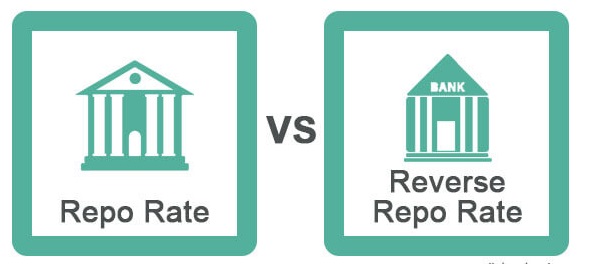In this article, we will take a closer look at the repo rate and reverse repo rate, explaining their meaning, importance, and impact on the economy. If you are a banker, investor, this article will provide you with all the information you require about repo rate and reverse repo rate in depth.
Introduction:
The repo rate and reverse repo rate are two crucial terms in the financial world that are often used by economists, bankers, and policymakers. The cost of borrowing, inflation, and economic growth are all significantly influenced by these rates. Generally speaking, few citizens are aware of the significance of these rates or how they impact the economy. In this article, we will dive deep into the repo rate and reverse repo rate, their significance, and their impact on various sectors.
What is Repo Rate and Reverse Repo Rate?
Repo rate and reverse repo rate are the interest rates at which the central bank lends money to commercial banks and other financial institutions. In India, these rates are established by the Reserve Bank of India (RBI), and they are routinely reviewed.Let us understand these two terms in detail:
Repo rate, also known as the repurchase rate, is the interest rate at which the central bank lends money to commercial banks. The commercial banks borrow money from the central bank by pledging government securities as collateral. The repo rate is used to control inflation and the money supply in the economy. The repo rate is raised by the RBI in order to lower inflation, which increases the cost of borrowing money for commercial banks and financial institutions In turn, this minimizes the amount of cash accessible in the economy, which reduces inflation.Reverse repo rate, on the other hand, is the interest rate at which the central bank borrows money from commercial banks. The commercial banks lend money to the central bank by pledging government securities as collateral. The reverse repo rate is used to control the money supply in the economy. Reducing the reverse repo rate, which makes it less advantageous for commercial banks to lend money to the central bank, allows the RBI to boost the money supply. As an outcome, the country's economic broad money increases and economic growth accelerates as well as growth increases.Why are Repo Rate and Reverse Repo Rate Important?
The repo rate and reverse repo rate play a crucial role in determining the cost of credit in the economy. These rates affect the lending and borrowing rates of commercial banks and other financial institutions, which turn to impact the cost of borrowing for individuals and businesses. Here are some reasons why repo rate and reverse repo rate are important:
Controlling Inflation: One of the primary objectives of the RBI is to control inflation. The repo rate is used to control inflation by making borrowing expensive for commercial banks, which reduces the money supply in the economy, leading to a decrease in inflation.
Encouraging Investments: When the reverse repo rate is low, commercial banks prefer to invest in government securities rather than lending money to the central bank. This turn to increases the money supply in the economy, leading to increased investments.
Boosting Economic Growth: For businesses, a low repo rate lowers the cost of borrowing, which pushes them to engage in new initiatives and grow their operations.
Maintaining Financial Stability: The repo rate and reverse repo rate also help in maintaining financial stability in the economy by regulating the liquidity and solvency of commercial banks.
On the other hand Reverse repo rate is the interest rate at which the central bank borrows money from commercial banks. The commercial banks lend money to the central bank by pledging government securities as collateral. The reverse repo rate is used to control the money supply in the economy. If the RBI wants to increase the money supply, it reduces the reverse repo rate, making it less profitable for commercial banks to lend money to the central bank. This, in turn, increases the money supply in the economy, leading to an increase in economic growth.
Why are Repo Rate and Reverse Repo Rate Important?
The repo rate and reverse repo rate play a crucial role in determining the cost of credit in the economy. These rates affect the lending and borrowing rates of commercial banks and other financial institutions, which, in turn, impact the cost of borrowing for individuals and businesses. Here are some reasons why repo rate and reverse repo rate are important:
Controlling Inflation: One of the primary objectives of the RBI is to control inflation. The repo rate is used to control inflation by making borrowing expensive for commercial banks, which reduces the money supply in the economy, leading to a decrease in inflation.
Encouraging Investments: When the reverse repo rate is low, commercial banks prefer to invest in government securities rather than lending money to the central bank. Which increases the money supply in the economy, leading to increased investments.
Boosting Economic Growth: A low repo rate reduces the cost of borrowing for businesses, which encourages them to invest in new projects and expand their operations.
Maintaining Financial Stability: The repo rate and reverse repo rate also help in maintaining financial stability in the economy by regulating the liquidity and solvency of commercial banks.
How Do Repo Rate and Reverse Repo Rate Affect the Stock Market?
The repo rate and reverse repo rate have a significant impact on the stock market. When the RBI increases the repo rate, the cost of borrowing for commercial banks increases, which reduces the money supply in the economy. This will leads to a decrease in consumer spending, which affects the revenue and profits of companies. This result, share prices may decrease, and the overall stock market may experience a decline.
On the other hand, when the RBI reduces the reverse repo rate, commercial banks have less incentive to invest in government securities. This will leads to an increase in lending, which increases the money supply in the economy. Result of this action leads to an increase in consumer spending, which may boost the revenue and profits of companies. As a result, share prices may increase, and the overall stock market may experience an upswing.
It is important to note that the impact of the repo rate and reverse repo rate on the stock market is not direct, and other factors such as company performance, global market trends, and investor sentiments also play a crucial role.
How Do Repo Rate and Reverse Repo Rate Affect the Banking Sector?
The repo rate and reverse repo rate have a significant impact on the banking sector. Commercial banks borrow money from the central bank at the repo rate and lend money to consumers and businesses at a higher interest rate, making a profit on the difference. Therefore, changes in the repo rate and reverse repo rate affect the profitability of commercial banks.
When the RBI increases the repo rate, the cost of borrowing for commercial banks increases, reducing their profitability. In such condition, banks may increase the interest rates on loans, making borrowing expensive for consumers and businesses. This may decreases loan demand and, in turn, a decrease in the money supply in the economy.
On the other hand, when the RBI reduces the reverse repo rate, commercial banks have less incentive to invest in government securities and may prefer to lend money to consumers and businesses. This increases their profitability and may lead to a decrease in interest rates on loans, making borrowing cheaper for consumers and businesses. This may increases loan demand and, in turn, an increase in the money supply in the economy.
Conclusion
The repo rate and reverse repo rate are crucial tools used by the RBI to regulate the money supply and control inflation. These rates also impact various sectors such as the stock market, banking sector, and overall economic growth. As an investor or a banker, understanding these rates and their impact is crucial for making informed decisions. By analyzing the prevailing economic conditions and the RBI's monetary policy, one can gain
a better understanding of the potential impact of repo rate and reverse repo rate changes on the economy and the financial markets.
While the repo rate and reverse repo rate are significant elements, they are not the only ones that have an impact on the financial markets and the economy. A significant effect is also played by other variables, including fiscal policies, global economic trends, and political developments.Therefore, investors and bankers should consider a holistic view of the economy and the markets while making investment decisions.
In summary, repo rate and reverse repo rate are crucial tools that the Reserve Bank of India uses to regulate the money supply and control inflation. These rates have a substantial impact on the entire economy and have an effect on a no. of industries, including the stock market,financial institution and the banking sector. As an investor or a banker, understanding these rates and their impact is crucial for making informed decision
FAQs
Q:What is the current repo rate in India?
A:As of April 2023, the current repo rate in India is 6.50%, and the reverse repo rate is 3.35%.
Q:How often does the RBI change the repo rate?
A:The RBI reviews the repo rate and reverse repo rate periodically and may revise them based on the prevailing economic conditions.
Q:How do repo rate and reverse repo rate affect inflation?
A:The repo rate and reverse repo rate affect inflation by regulating the money supply in the economy. An increase in the repo rate reduces the money supply, leading to a decrease in inflation. A decrease in the reverse repo rate increases the money supply, leading to an increase in inflation.
Q:Can the repo rate and reverse repo rate impact the stock market?
A:Yes, changes in repo rate and reverse repo rate can impact the stock market. When the central bank raises rates, it can lead to a decrease in stock prices, and vice versa.







